The beauty of the charm of Raja Ampat Island.
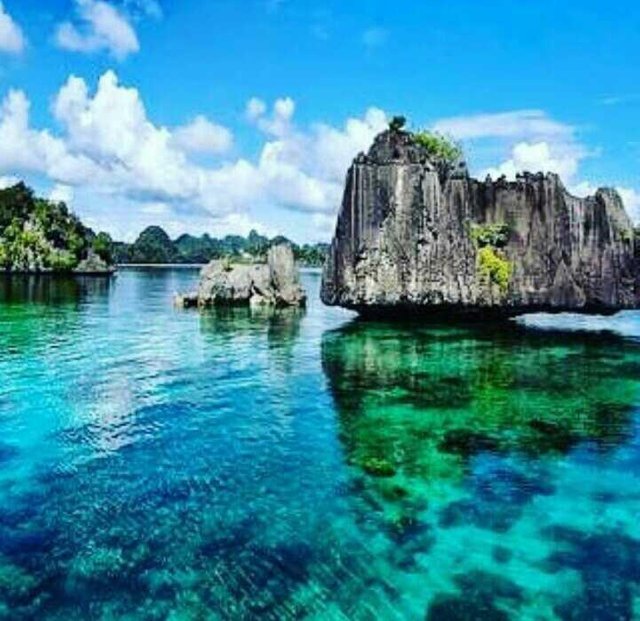
The Raja Ampat Islands is a series of four adjacent island clusters located in the western part of the Bird's Head (Vogelkoop) of Papua Island. Administratively, this cluster is under Raja Ampat Regency, West Papua Province. This islands are now the destination of divers who are interested in the beauty of underwater scenery. Four groups of islands are named according to the four largest islands, namely Waigeo Island, Misool Island, Salawati Island, and Batanta Island.
Origins and history.
The origin of the name Raja Ampat according to the myth of the local community comes from a woman who found seven eggs. Four of them hatch into four separated princes and each ruler of Waigeo, Salawati, Misool East and Misool West. Meanwhile, three other eggs became ghosts, a woman, and a stone.
In the course of history, Raja Ampat territory has long been inhabited by noble society and apply the customary system of Maluku. In this system, society is a group of people. Each village is led by a king. Since the founding of the five Muslim sultanates in Maluku, Raja Ampat became part of the claim of the Tidore Sultanate. After the Tidore Sultanate was subdued from the Netherlands, the Raja Ampat Islands became part of the claim of the Dutch East Indies.
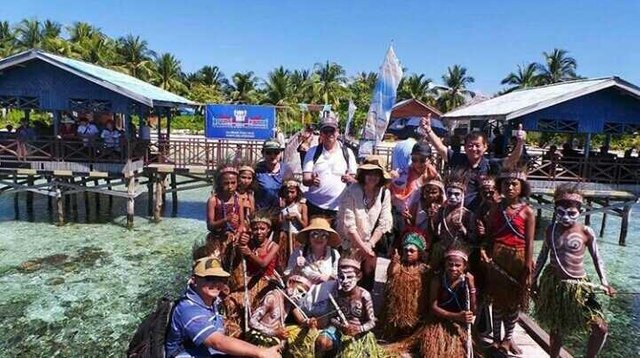
Society.
The people of the Raja Ampat Islands are generally traditional fishermen who live in small villages located far apart and different islands. They are a friendly society to receive guests from outside, especially if we bring gifts for them in the form of areca or candy. This item became a kind of 'indian peace pipe' in Raja Ampat. The show chatted with eating pinang also called "Para-the Pinang" often take turns to each other throwing mobs, the local term for funny stories.
They are Muslims and Christians and often in one family or clan there is a member who embraces one of the two religions. This makes the people of Raja Ampat remain harmonious despite different beliefs.
Society.
The people of the Raja Ampat Islands are generally traditional fishermen who live in small villages located far apart and different islands. They are a friendly society to receive guests from outside, especially if we bring gifts for them in the form of areca or candy. This item became a kind of 'indian peace pipe' in Raja Ampat. The show chatted with eating pinang also called "Para-the Pinang" often take turns to each other throwing mobs, the local term for funny stories.
They are Muslims and Christians and often in one family or clan there is a member who embraces one of the two religions. This makes the people of Raja Ampat remain harmonious despite different beliefs.
wobbegong, and Manta stingrays. There is also a fish endemic king of amphibians, namely Eviota king, which is a kind of gobbie fish. At the Manta point located in Arborek Dampier Strait, you can dive with the company of some Pari Manta tame as you dive in the Derawan Islands, East Kalimantan. If you dive in Cape Kri or Chicken Reef, you can be surrounded by thousands of fish. Sometimes a collection of tuna, giant trevallies and snappers. But it is exciting if we are surrounded by a collection of barracuda fish, although in fact it is relatively harmless (which is dangerous if we meet solitary or solitary barracudas). Coral sharks are also often seen, and if lucky you can also see turtles are still eating sponge or swimming around you. In some places like in Salawati, Batanta and Waigeo also seen Dugong or mermaid.
Because of its many islands and narrow straits, most of the dive sites at any given time have strong currents. It is also possible to do drift dive, dive while following a strong current with very clear wa
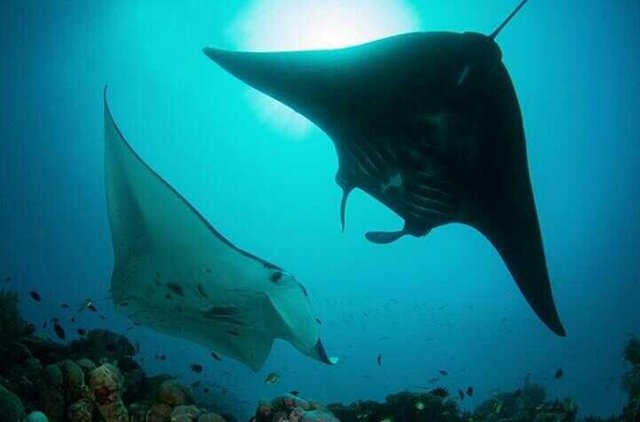
The richness of natural resources.
Raja Ampat Islands is a very potential place to serve as a tourist attraction, especially diving tour. The waters of the Raja Ampat Islands according to various sources, is one of the 10 best waters for diving sites around the world. In fact, it may also be recognized as number one for the completeness of underwater flora and fauna at this time.
Dr John Veron, an experienced rock expert from Australia, for example, in a site he revealed, Raja Ampat Islands located at the westernmost tip of Papua Island, about 50 miles northwest of Sorong, has the best coral reefs in Indonesia. About 450 species of corals were identified during two weeks of research in the area.
Conservation International, The Nature Conservancy, and the National Oceanographic Institute (LON) of the Indonesian Institute of Sciences (LIPI) conducted rapid assessments in 2001 and 2002. As a result, they noted that in these waters there were more than 540 hard corals (75% of the total species in the world), more than 1,000 species of reef fish, 700 species of mollusks, and the highest record for gonodactyloid stomatopod crustaceans. This makes up 75% of the world's coral species in Raja Ampat. No place with the same area has as many coral species as this.
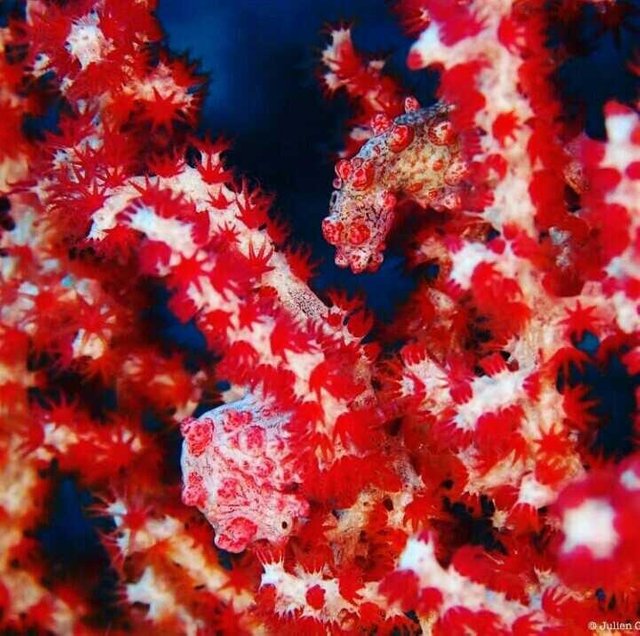
There are some coral reefs that are still very good condition with the percentage of live coral cover up to 90%, ie in Dampier strait (strait between Waigeo Island and Batanta Island), Kofiau Islands, Southeast Misool Islands and Wayag Islands. The types of coral reefs in Raja Ampat are generally coral reefs with sloping contours to steep. But also found type of atoll and type of burn or taka. In some places such as Saondarek village, when the lowest tides, can be seen coral reefs without diving and with its own adaptation, the coral can still live even in the open air and exposed to direct sunlight.
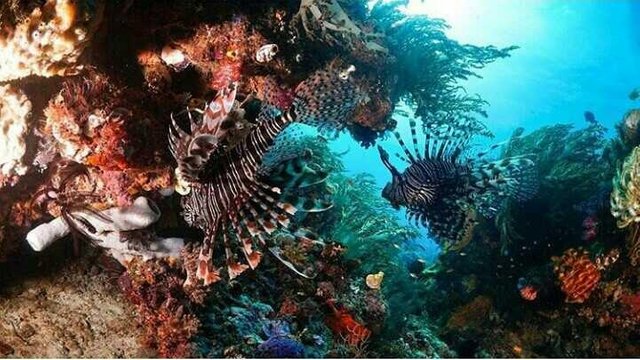
Unique species that can be found at the time of diving are several types of sea horses dwarf, wobbegong, and Manta stingrays. There is also a fish endemic king of amphibians, namely Eviota king, which is a kind of gobbie fish. At the Manta point located in Arborek Dampier Strait, you can dive with the company of some Pari Manta tame as you dive in the Derawan Islands, East Kalimantan. If you dive in Cape Kri or Chicken Reef, you can be surrounded by thousands of fish. Sometimes a collection of tuna, giant trevallies and snappers. But it is exciting if we are surrounded by a collection of barracuda fish, although in fact it is relatively harmless (which is dangerous if we meet solitary or solitary barracudas). Coral sharks are also often seen, and if lucky you can also see turtles are still eating sponge or swimming around you. In some places like in Salawati, Batanta and Waigeo also seen Dugong or mermaid.
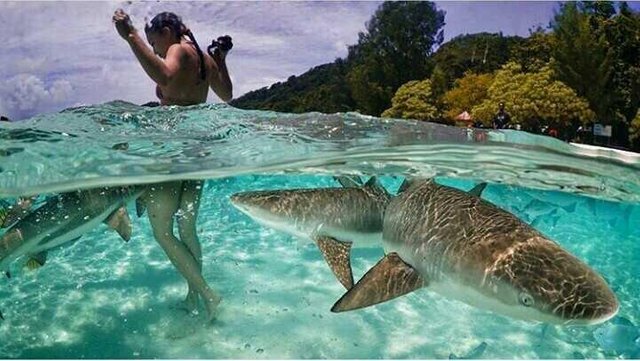
Because of its many islands and narrow straits, most of the dive sites at any given time have strong currents. It is also possible to do drift dive, dive while following a strong current with very clear water while through the collection of fish.
Relics of prehistory and history.
In the area of Misool cluster found a relic of prehistoric in the form of a hand stamp imprinted on the rock wall. Uniquely, the hand caps are very close to sea level and not in the cave. According to estimates, the age of the hand-stamp is about 50,000 years old and is part of a series of guidance for human pathways from western Nusantara to Papua and Melanesia.
The rest of the World Wide II wreckage can be found in several dive sites, such as on Wai Island.
Access.
Visiting these islands is not too difficult though it takes a lot of time and money. We can use airlines from Jakarta or Bali to Sorong via Makassar or Ambon and Manado for approximately 6 hours flight. From Sorong, a fairly large city with complete facilities. To explore Raja Ampat there are two choices, touring with pinisi boat or staying at the Raja Ampat Dive Lodge resort. Although most tourists who come to Raja Ampat today are divers, this location is actually also attractive for non-divers tourists because it also has beautiful white sandy beaches, a cluster of karst nan islands and enchanting and endemic unique endemic flora-fauna such as cendrawasih red, cendrawasih Wilson, maleo waigeo, various parrots and parrots, kuskus waigeo, and various types of orchids.
Threats to these islands.
The richness of biodiversity in Raja Ampat has made itself a high degree of threat. It can be seen from the damage of coral reefs and forests. Damage to coral reefs is generally due to unfriendly fishing activities such as bombs, cyanide and bore roots (liquids from processed root of a kind of tree to poison fish).
Conservation efforts.
To maintain the underwater sustainability of the Raja Ampat Islands, conservation efforts are indispensable in this area. There are two international agencies that concentrate on the sustainability of Raja Ampat's natural resources, namely CI (Conservation International) and TNC (The Nature Conservancy). The government itself has set up a sea around Waigeo South, which includes small islands such as Gam, Mansuar, the Yeben group and the Batang Pele group, has been ratified as Marine Marine Sanctuary. According to Minister of Forestry Decree No. 81 / KptsII / 1993, the total area reaches 60,000 hectares.
In addition, several other marine areas have been proposed to become conservation areas. Each is the Marine Wildlife Sanctuary of South Misool Island, the sea of Kofiau Island, the sea of Asia Island, the sea of Sayang Island and the sea of Ayau Island.
Congratulations! This post has been upvoted from the communal account, @minnowsupport, by Mustaghfirridwan from the Minnow Support Project. It's a witness project run by aggroed, ausbitbank, teamsteem, theprophet0, someguy123, neoxian, followbtcnews, and netuoso. The goal is to help Steemit grow by supporting Minnows. Please find us at the Peace, Abundance, and Liberty Network (PALnet) Discord Channel. It's a completely public and open space to all members of the Steemit community who voluntarily choose to be there.
If you would like to delegate to the Minnow Support Project you can do so by clicking on the following links: 50SP, 100SP, 250SP, 500SP, 1000SP, 5000SP.
Be sure to leave at least 50SP undelegated on your account.